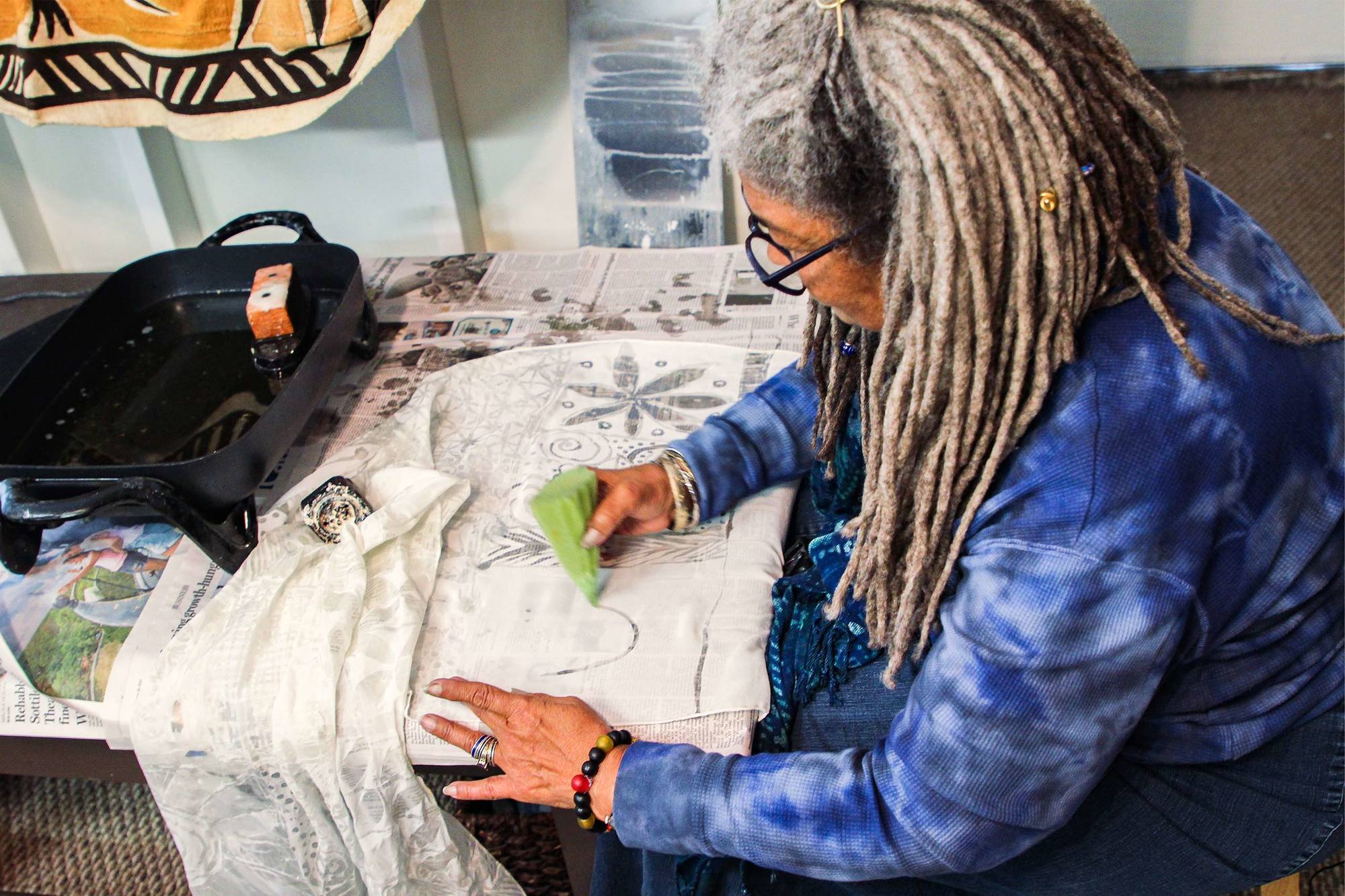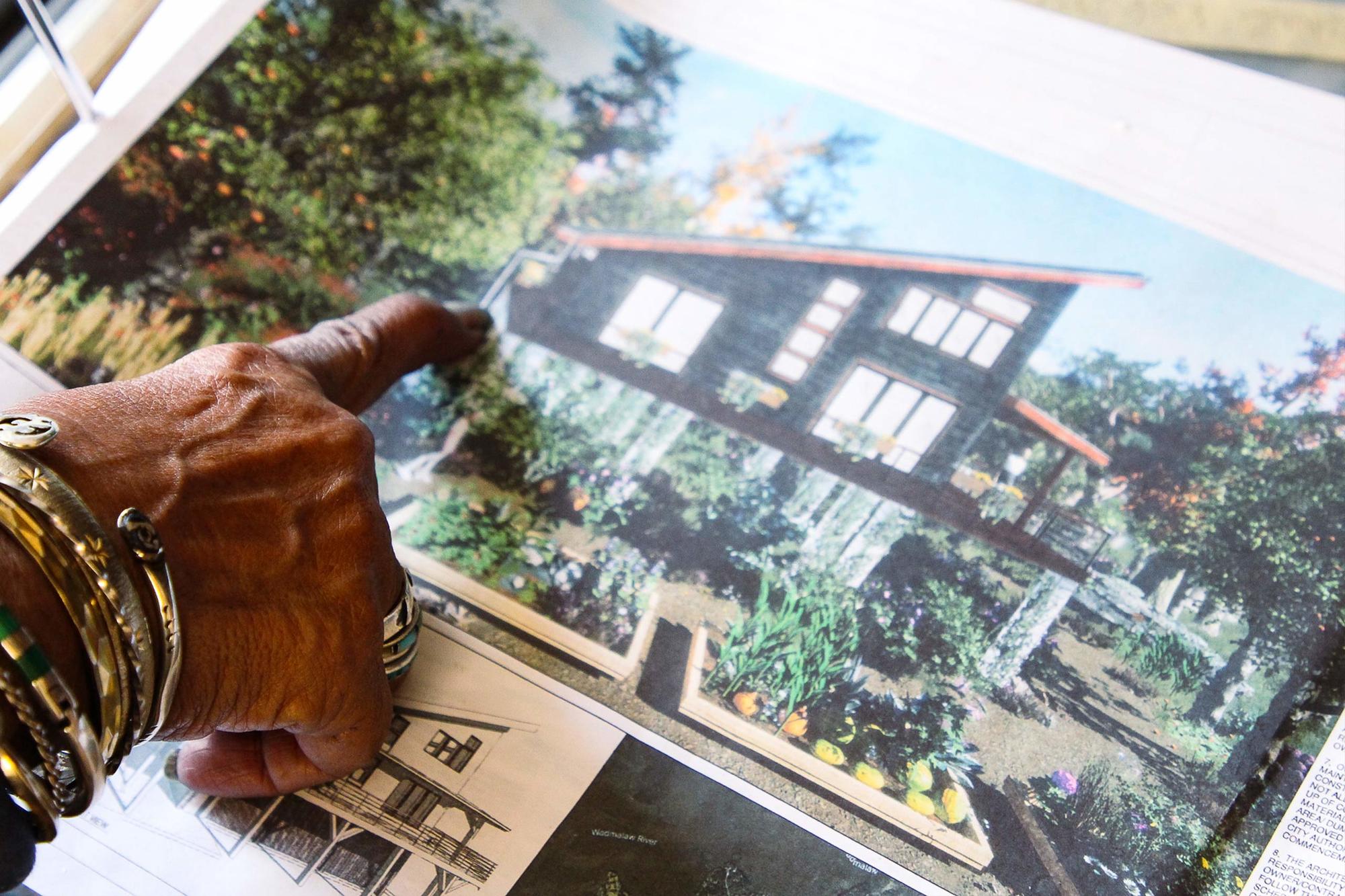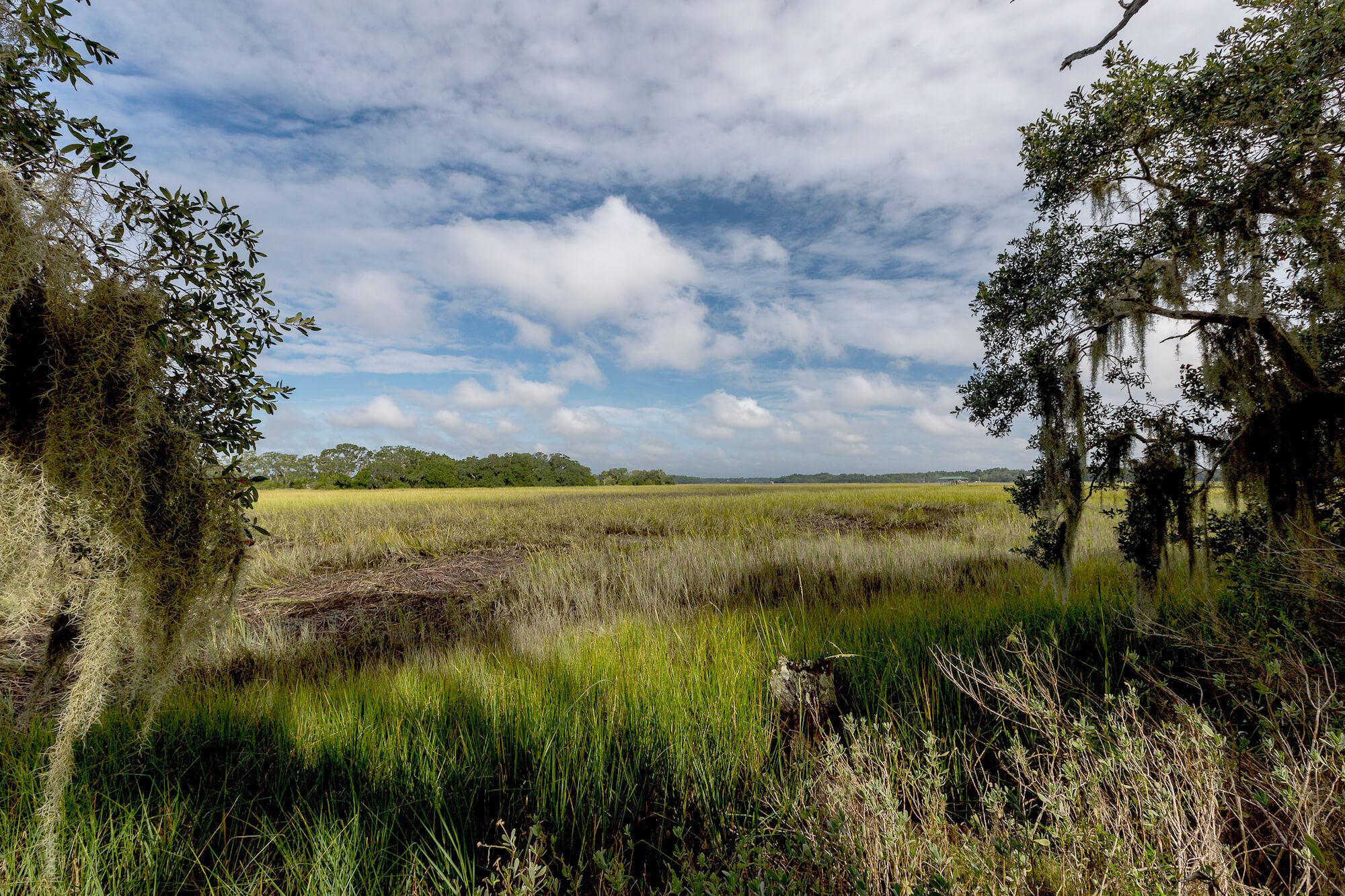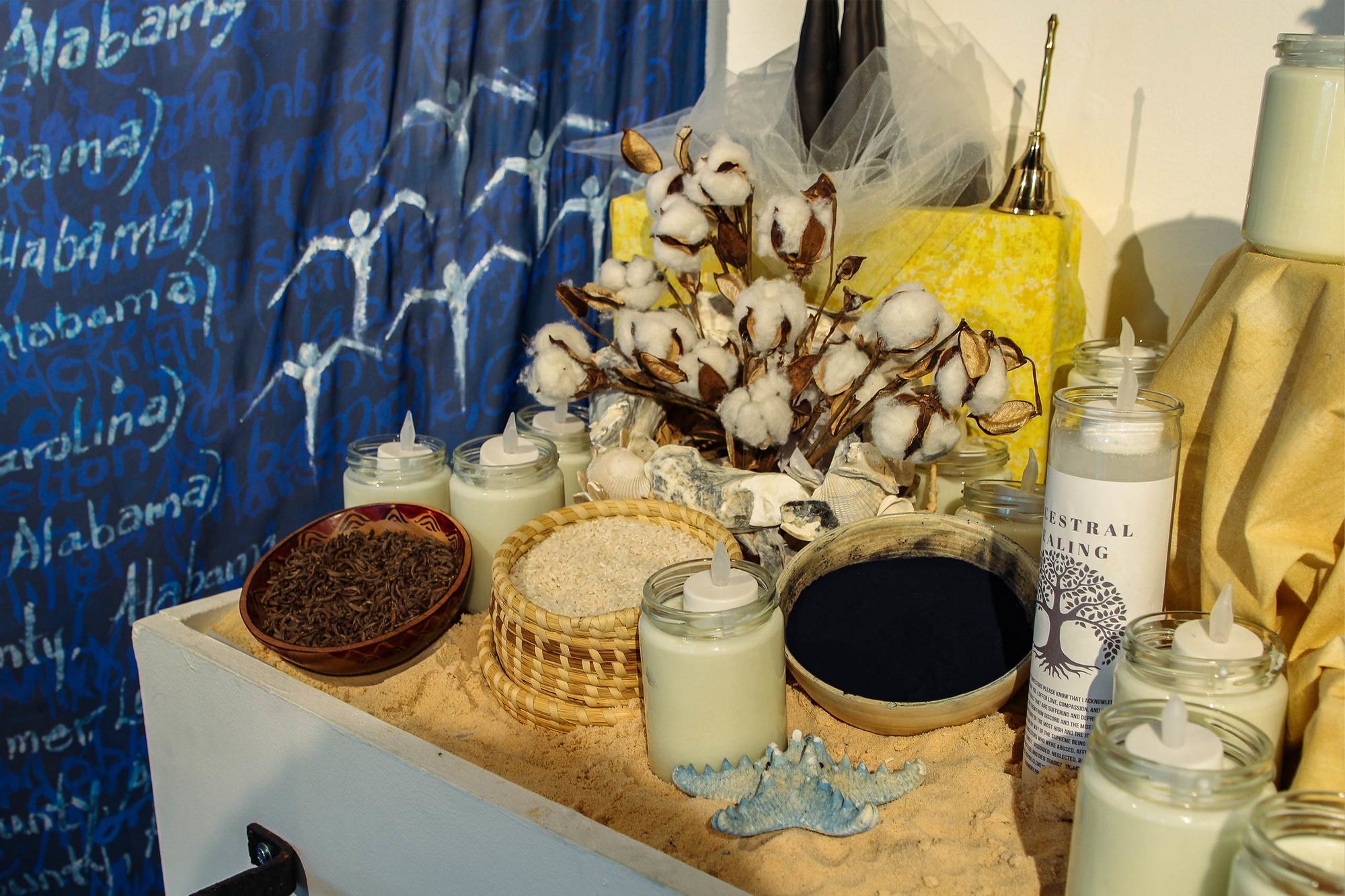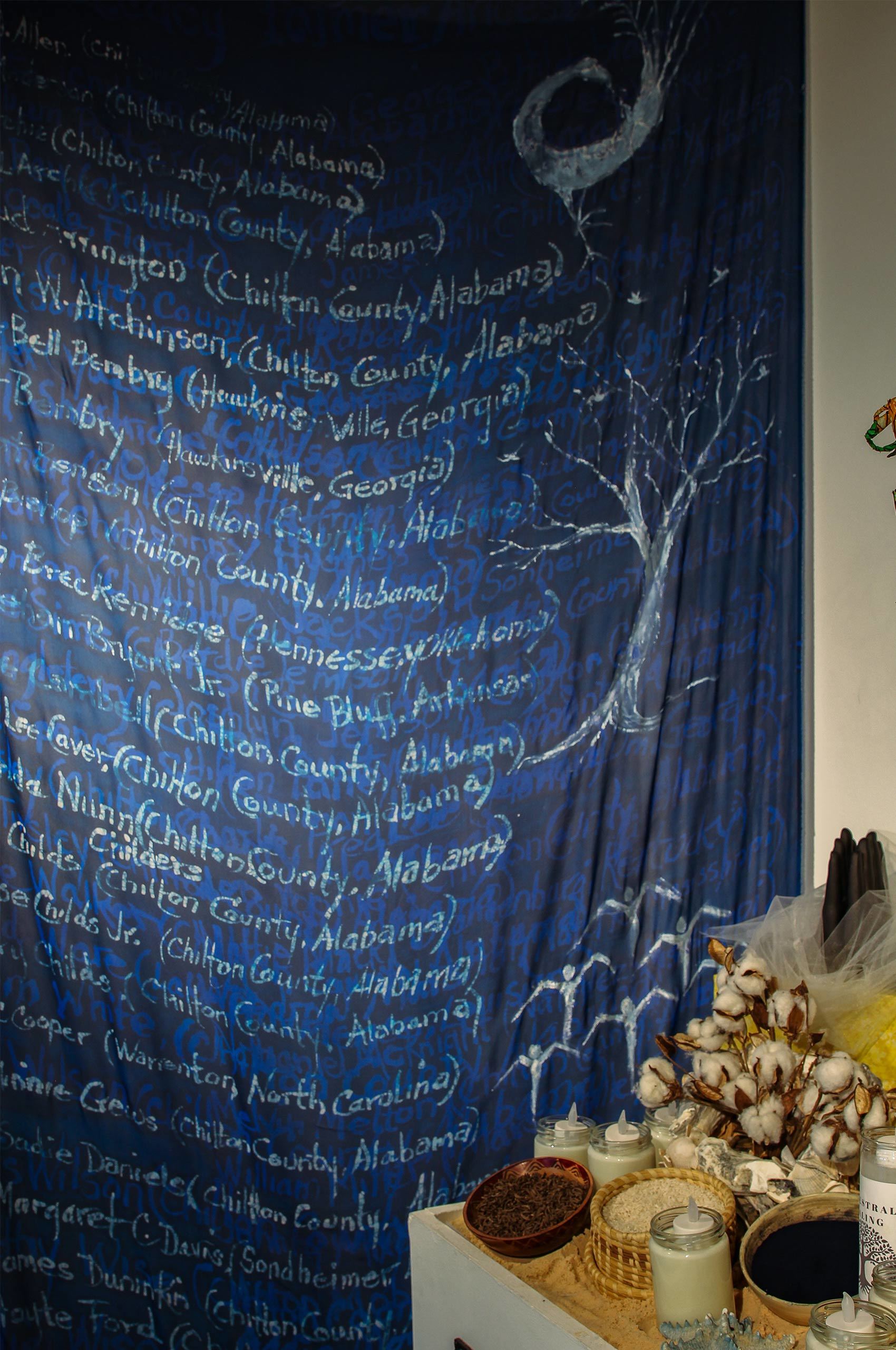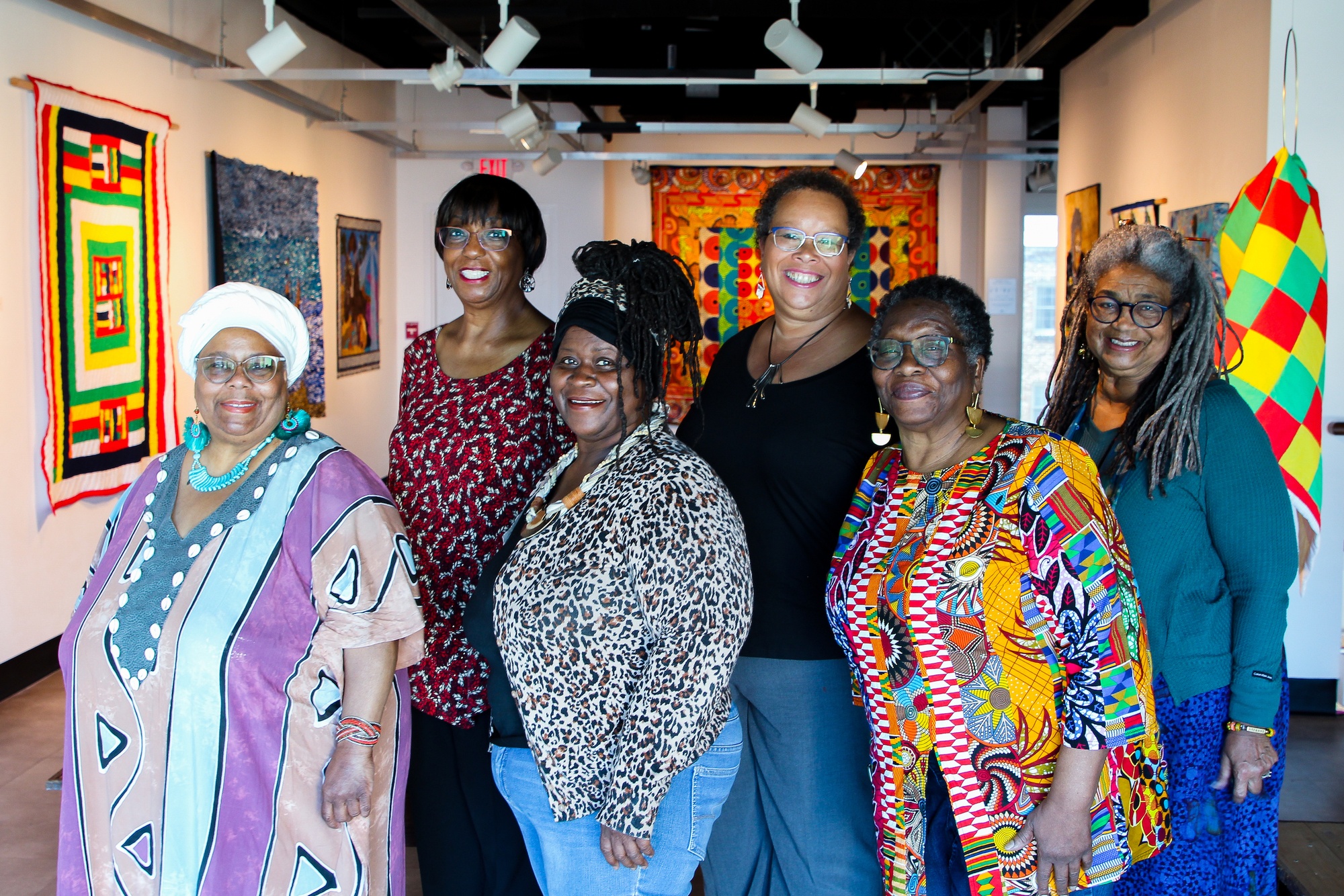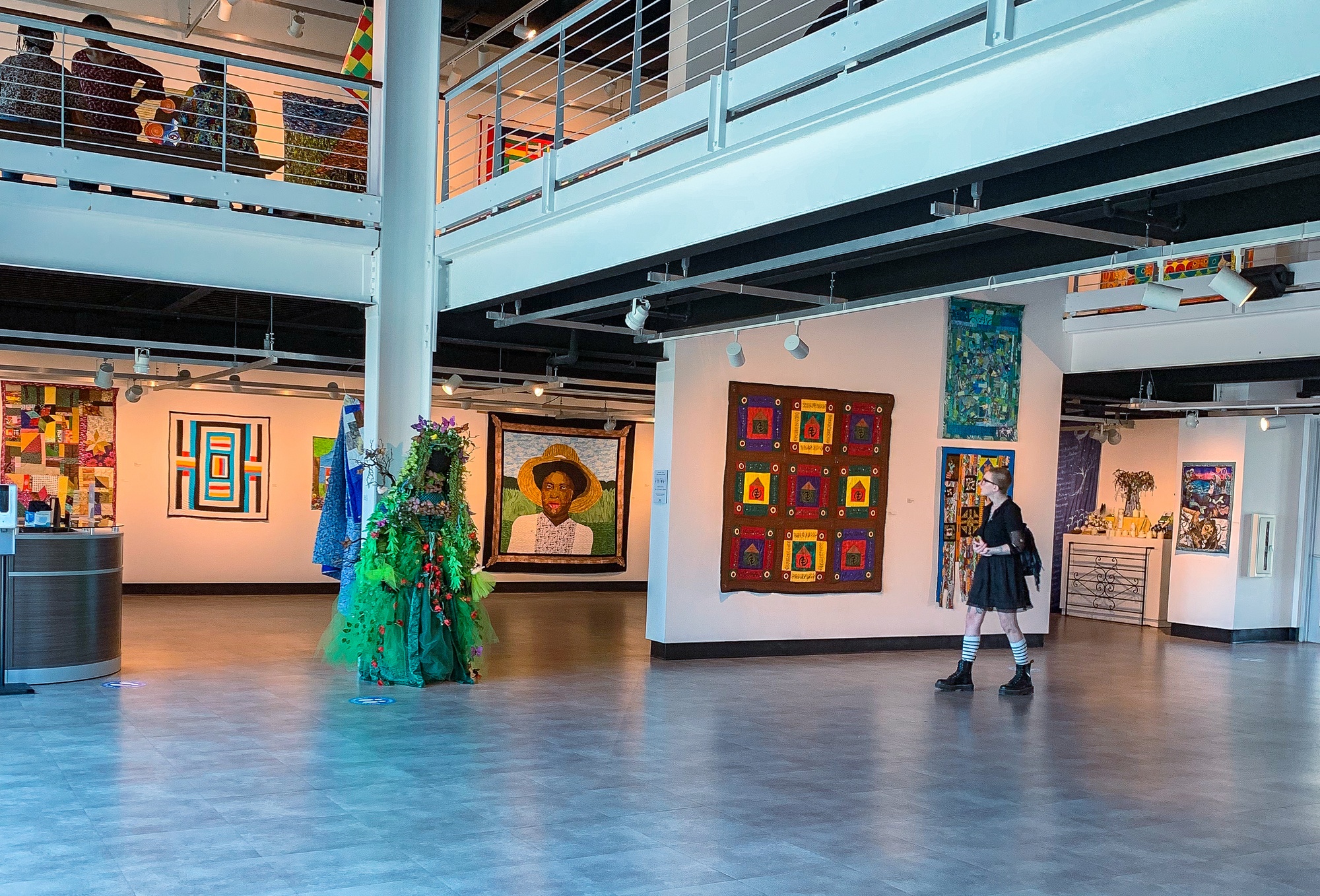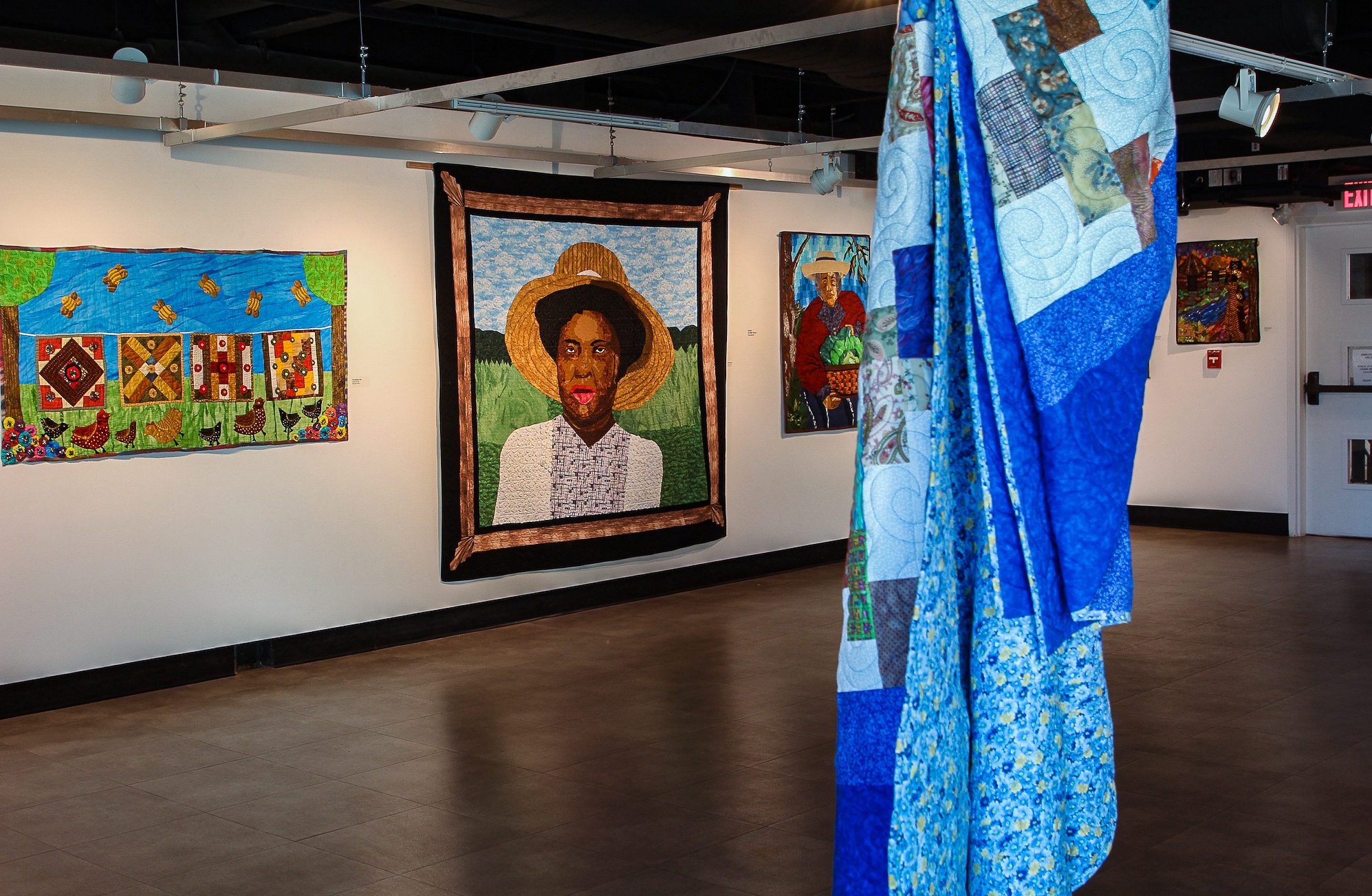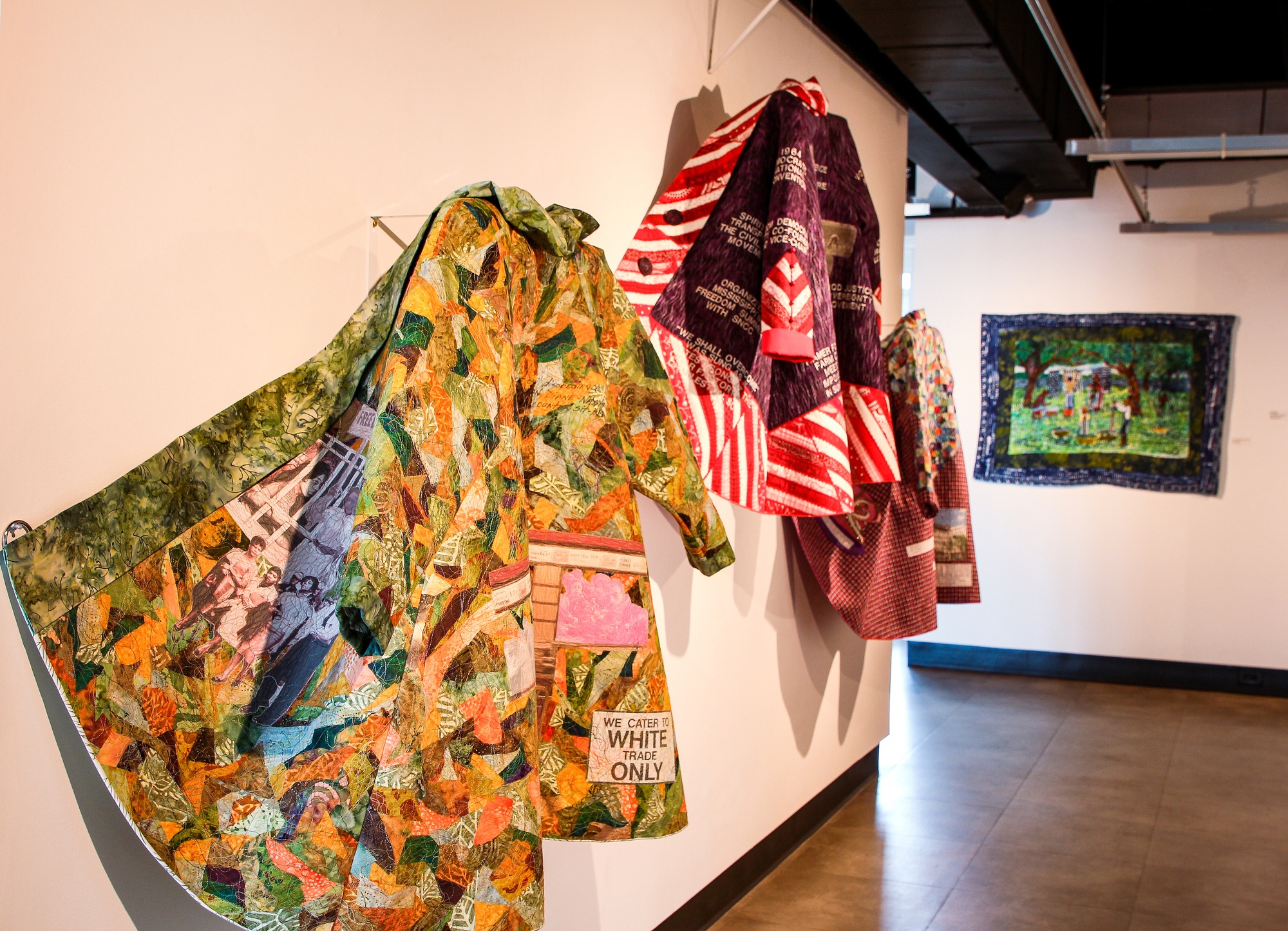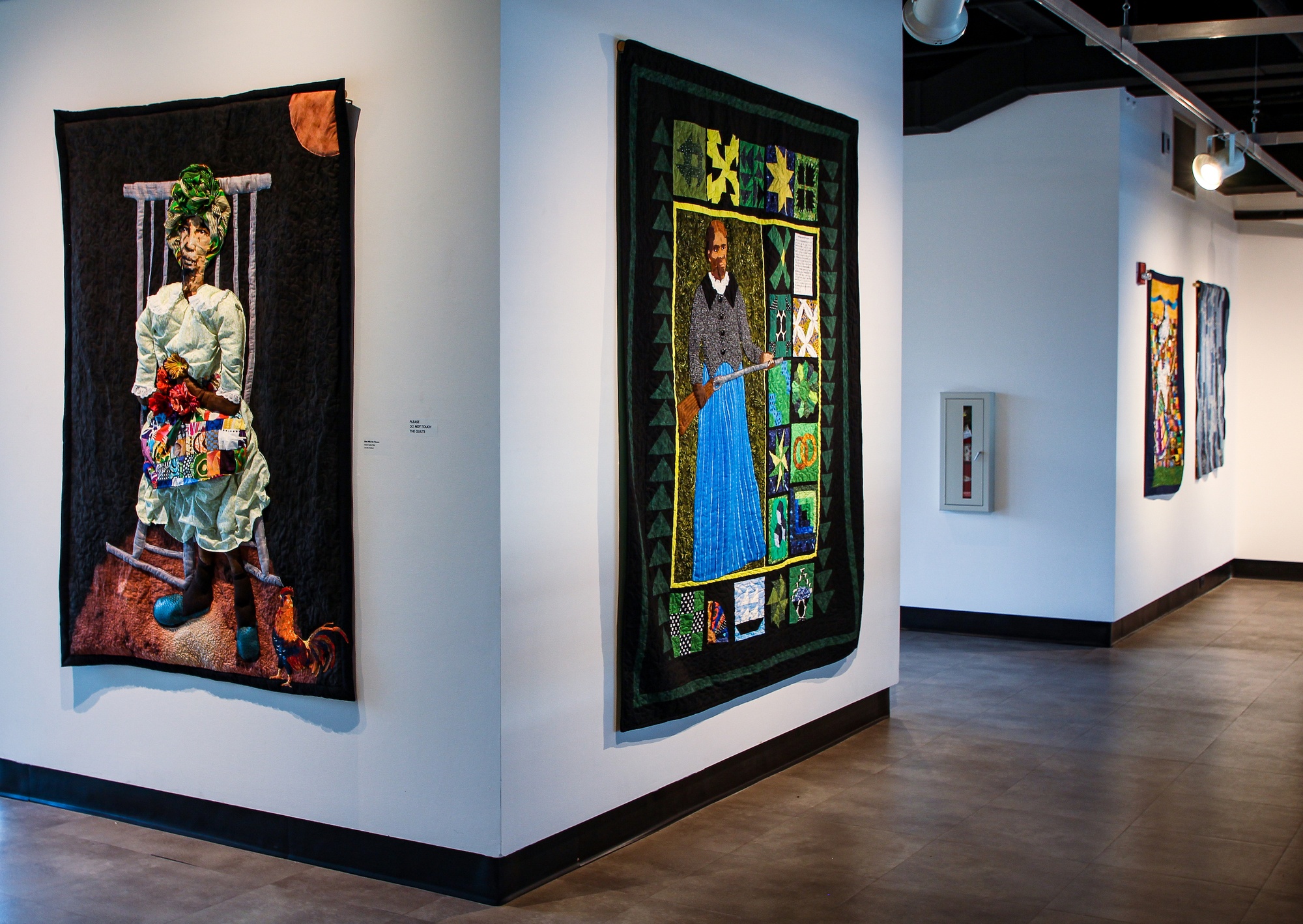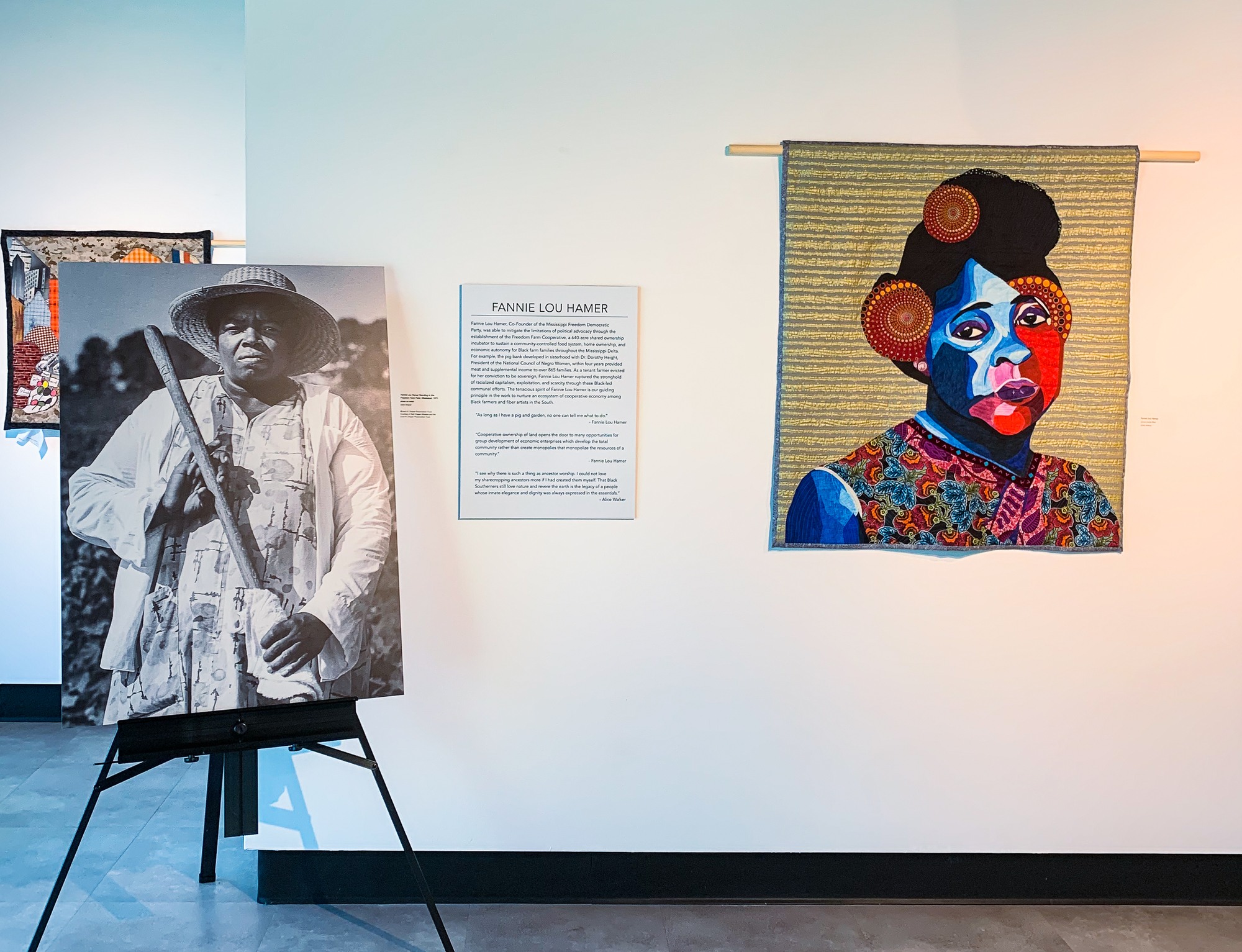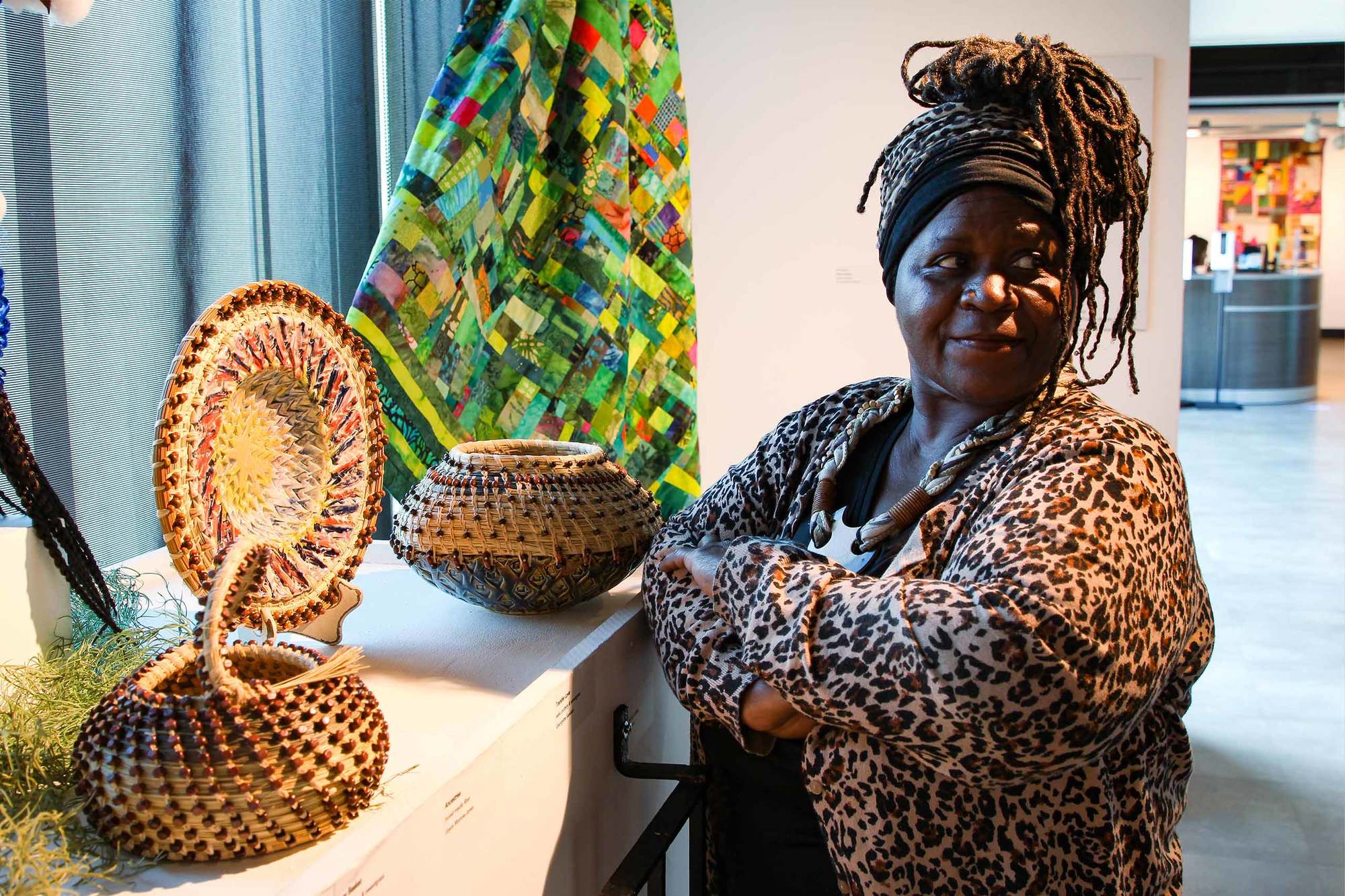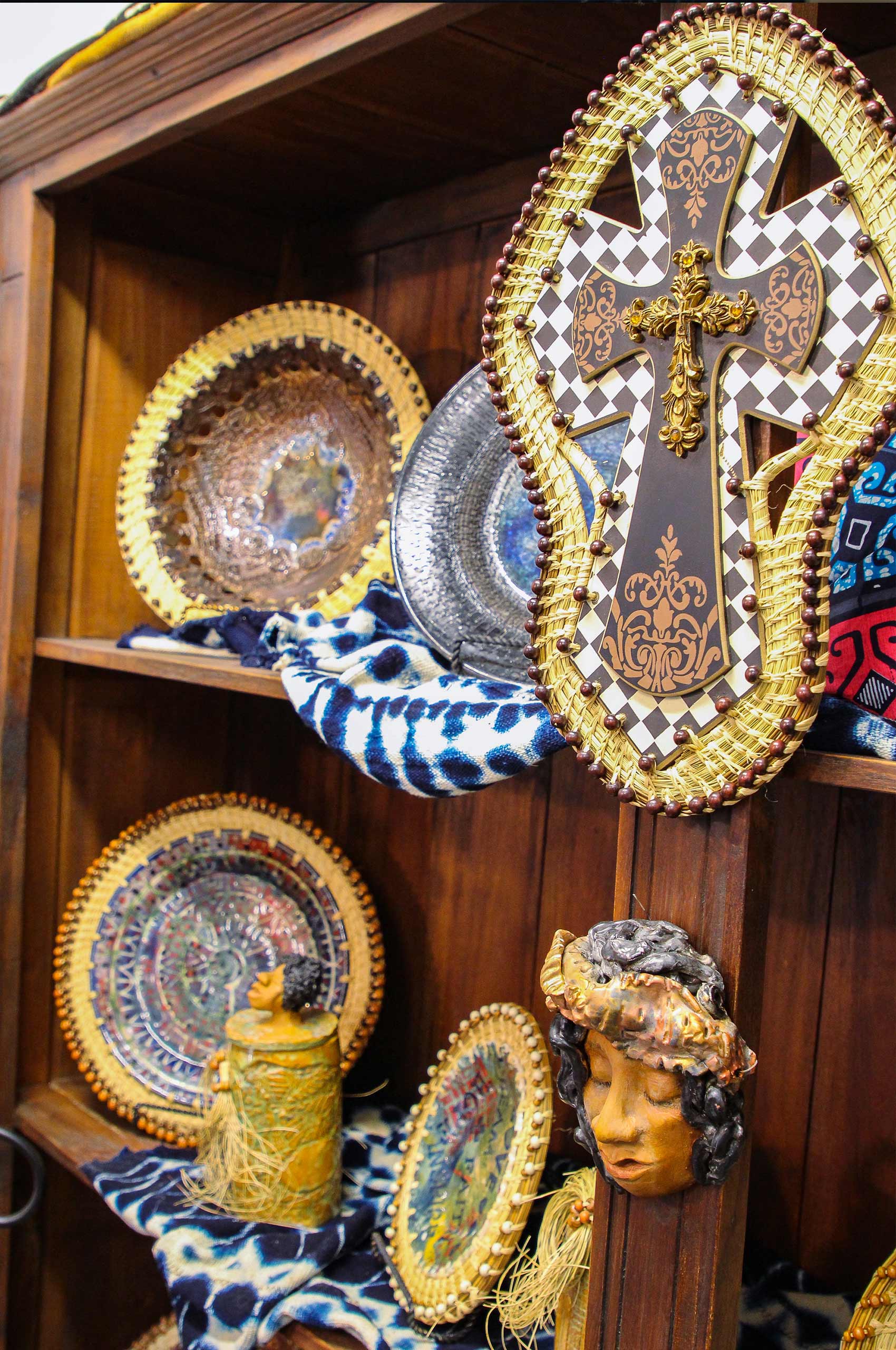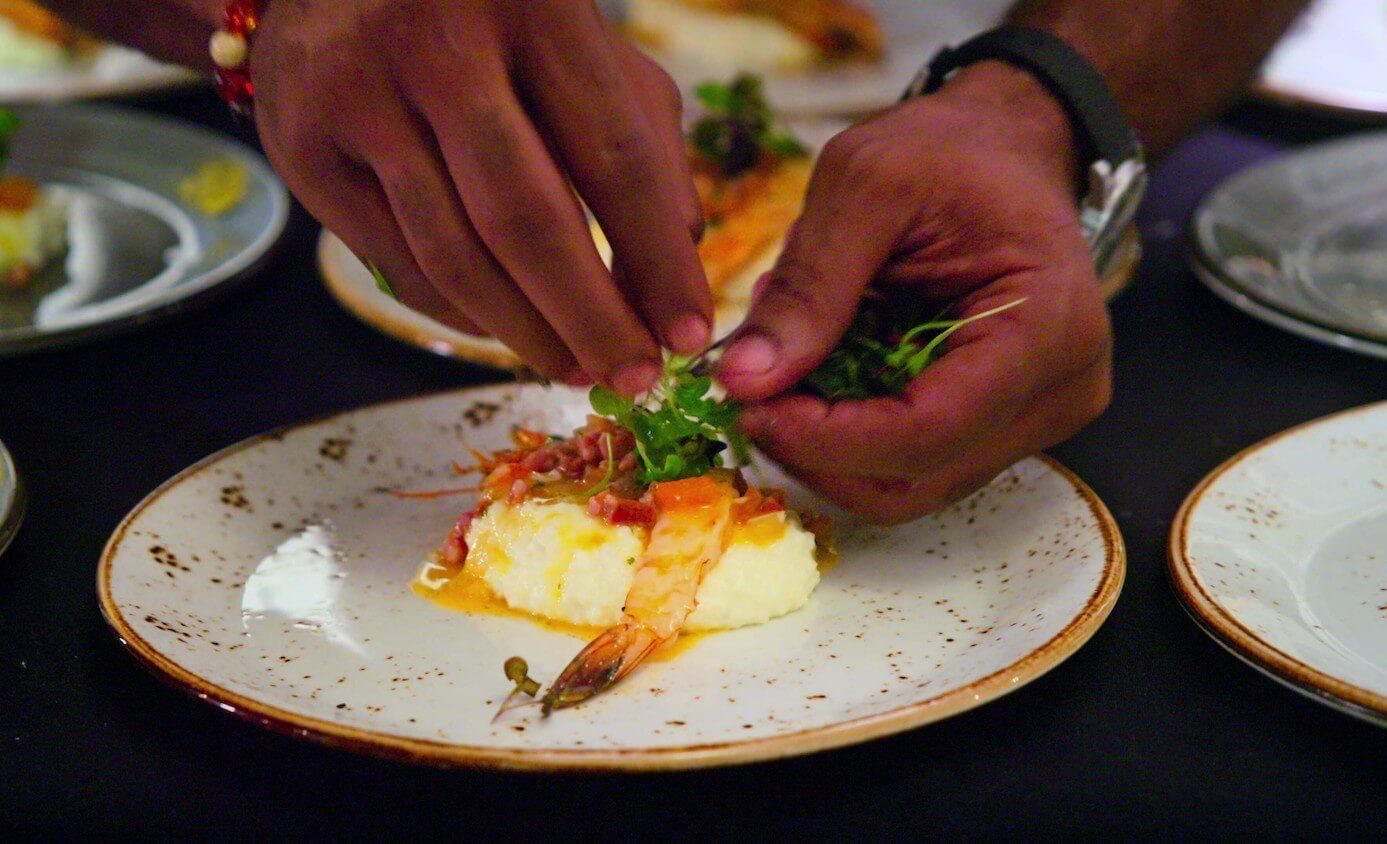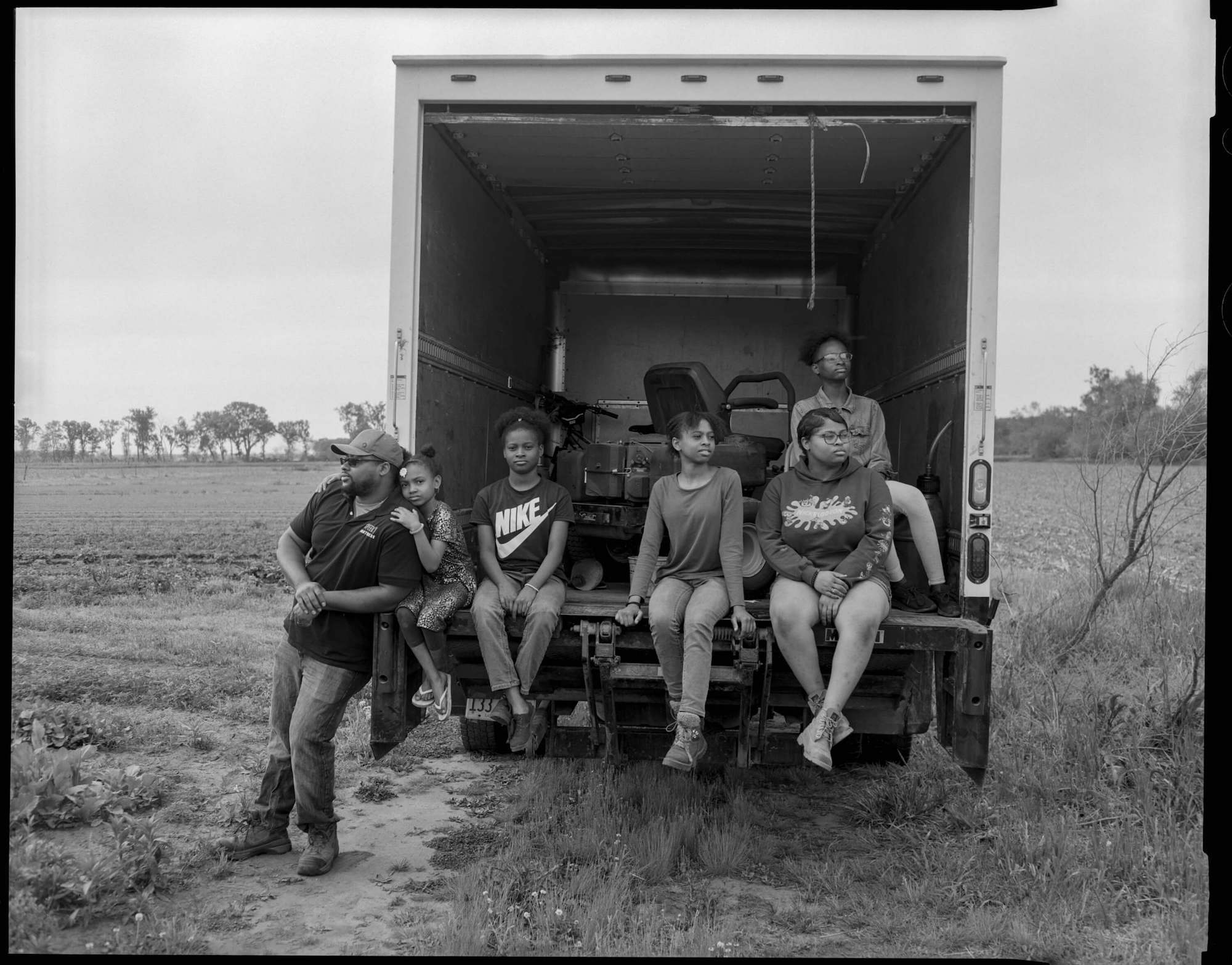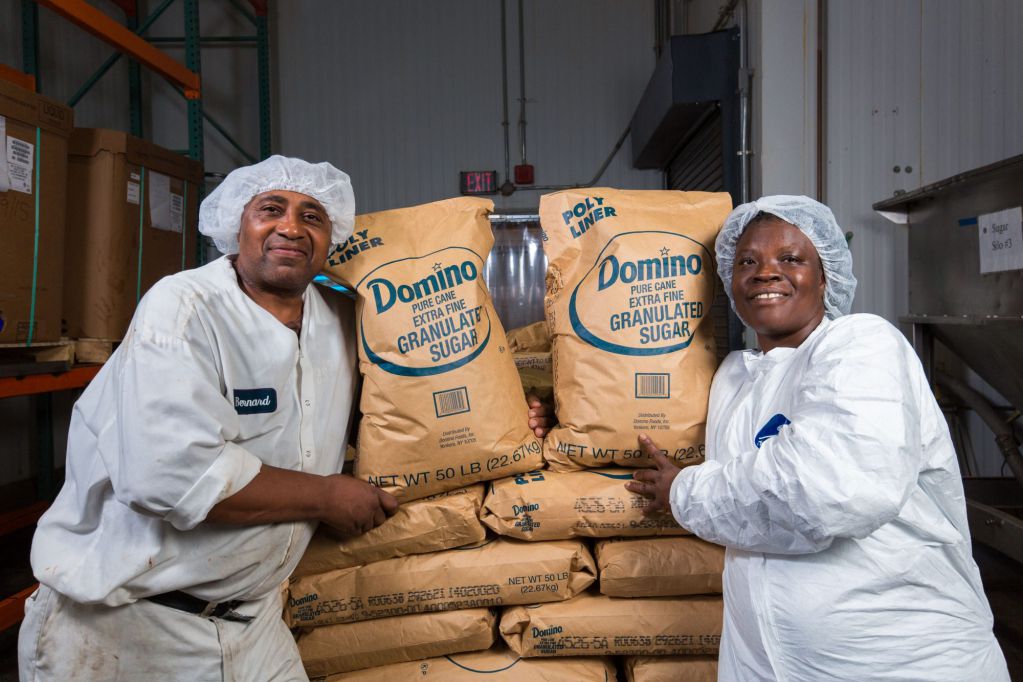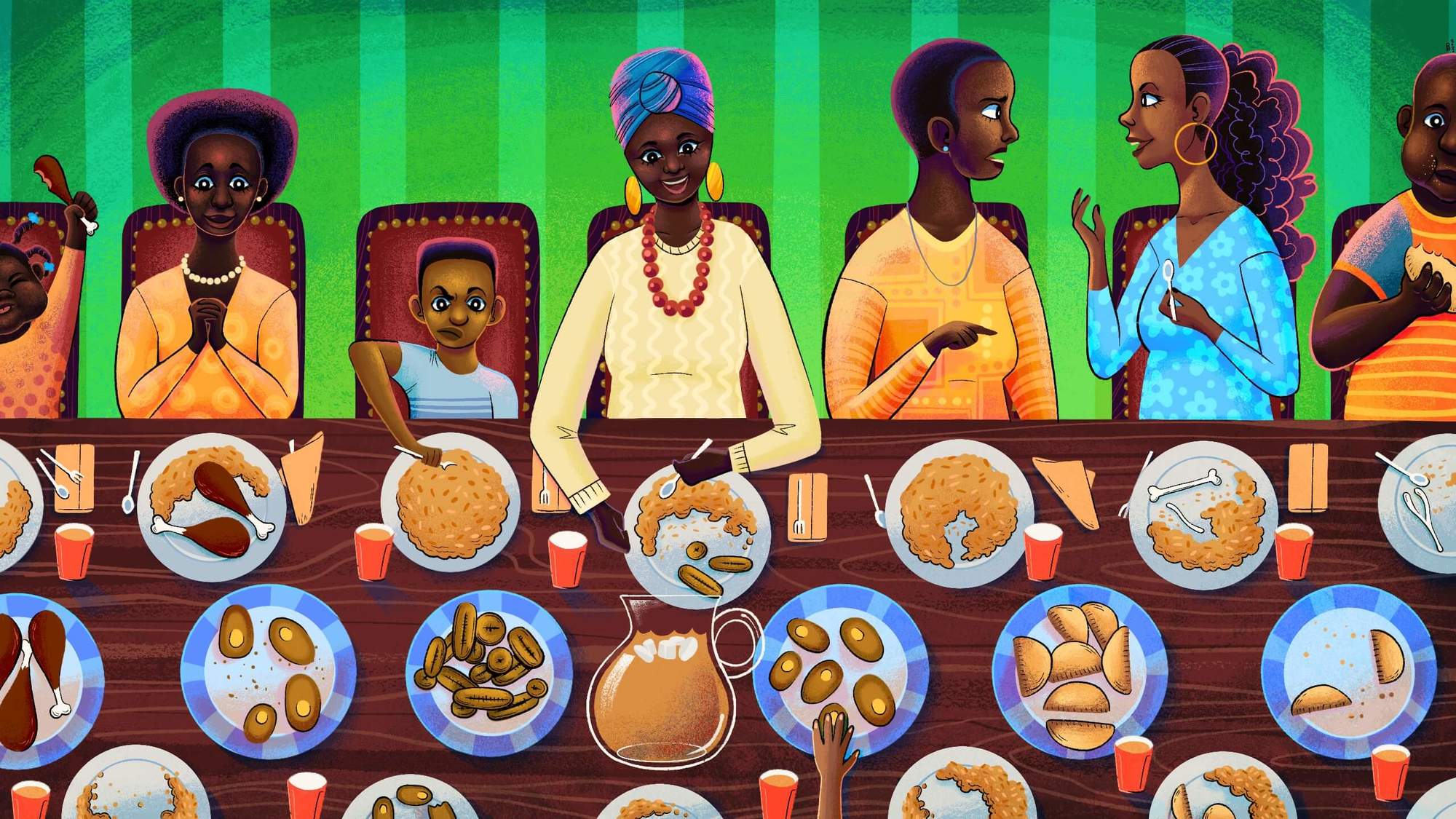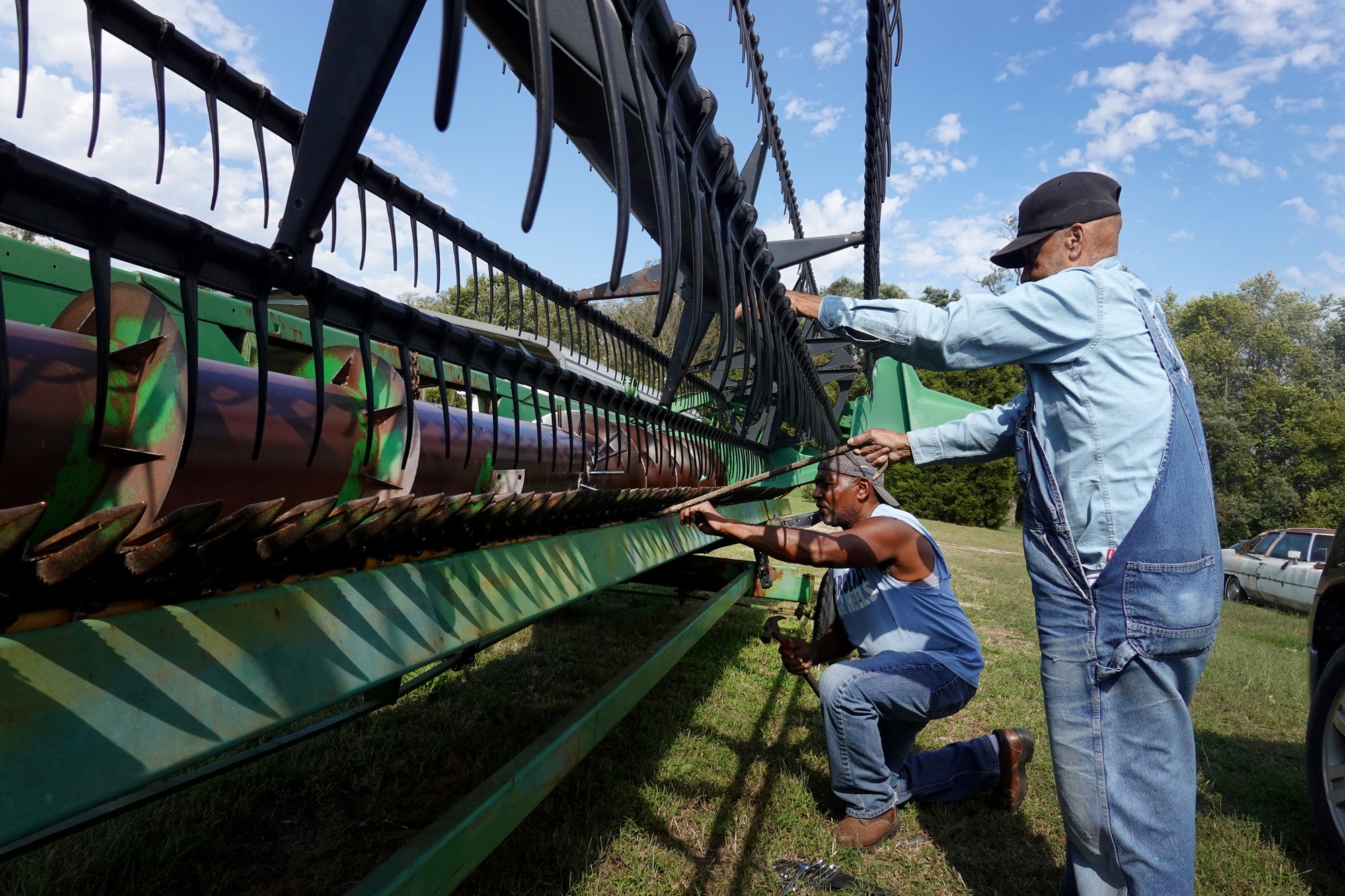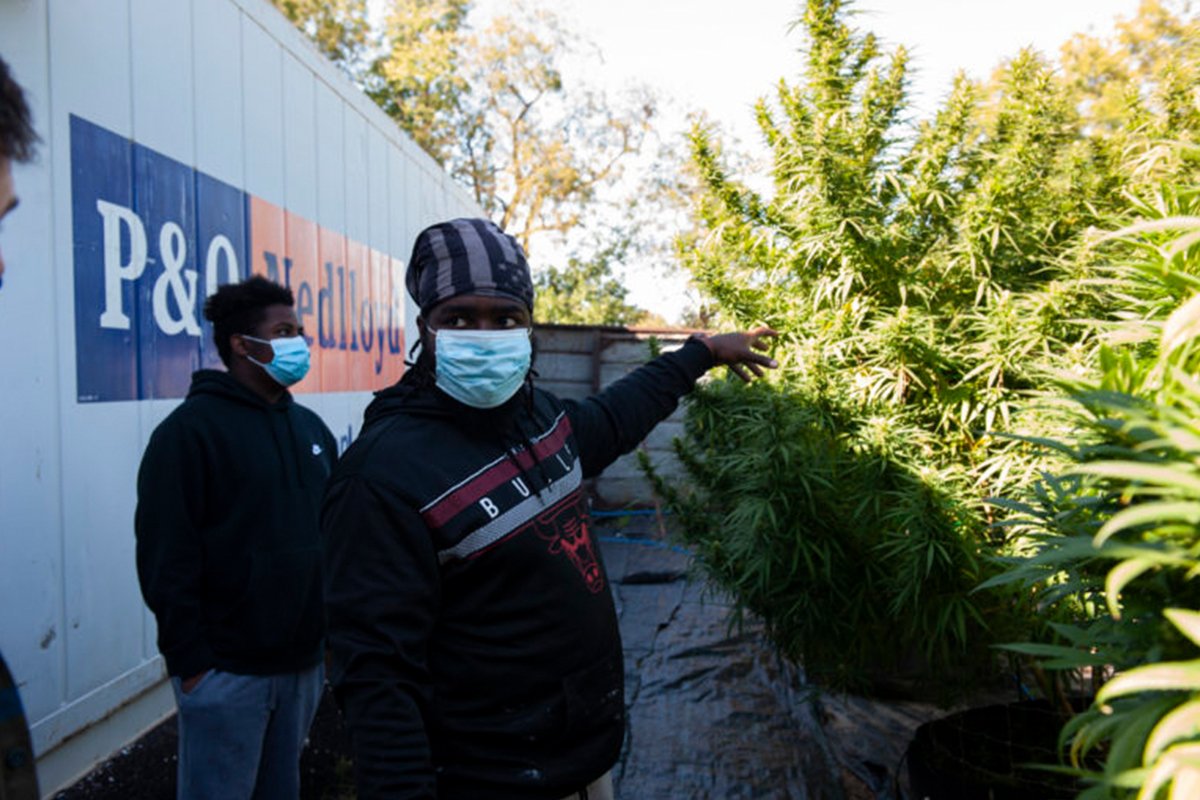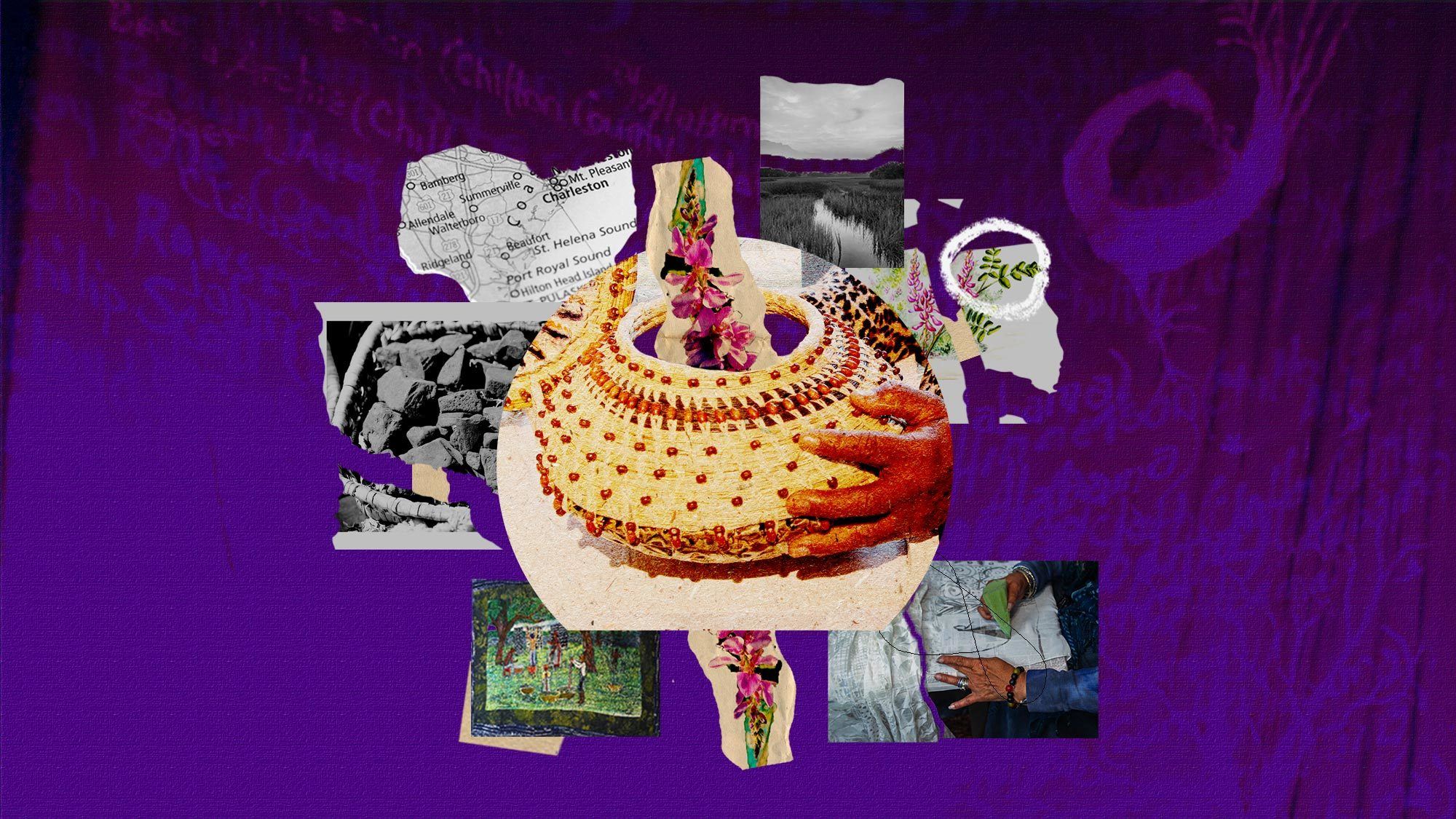
Graphic by Alex Hinton | Source Images: Talia Moore, Tricia Vuong, iStock
Although their work centers on raw, natural materials, the textile and fiber artists say they never intended to become agricultural producers—the sustainability of their craft demanded it.
When Arianne King Comer stepped into a mass of head-high indigo, thick with mosquitos and whining like a vexed tea kettle yet to erupt—snakes and who knows what else crawling underfoot—she wondered what she had gotten herself into when she moved to St. Helena Island, hoping to grow the herbaceous plant.
King Comer, a Virginia-born indigo textile artist, had come to the South Carolina sea island, one of more than a hundred hugging the Atlantic coast from North Carolina to Florida, in 1995 as a state artist in residence. A few years prior, she had returned from Osogbo, Nigeria, where she studied the traditional practice of Batik, a method of creating hand-printed textiles using wax and natural plant dyes such as indigo, under renowned Yoruba artist Nike Olaniyi Davies.
On the island, King Comer founded the Ibile Indigo House, where, for six years, she taught hundreds of students the West African method of dye work. St. Helena is a bastion of African American heritage and tradition in the Lowcountry—a geographic and cultural region comprised of South Carolina’s eleven southernmost counties; home to the Penn Center, one of the country’s first schools founded to educate formerly enslaved people. It has since become a premier site for the historical preservation of Gullah-Geechee culture, which flourished throughout these Southeastern coastal islands, in part, due to their former isolation.
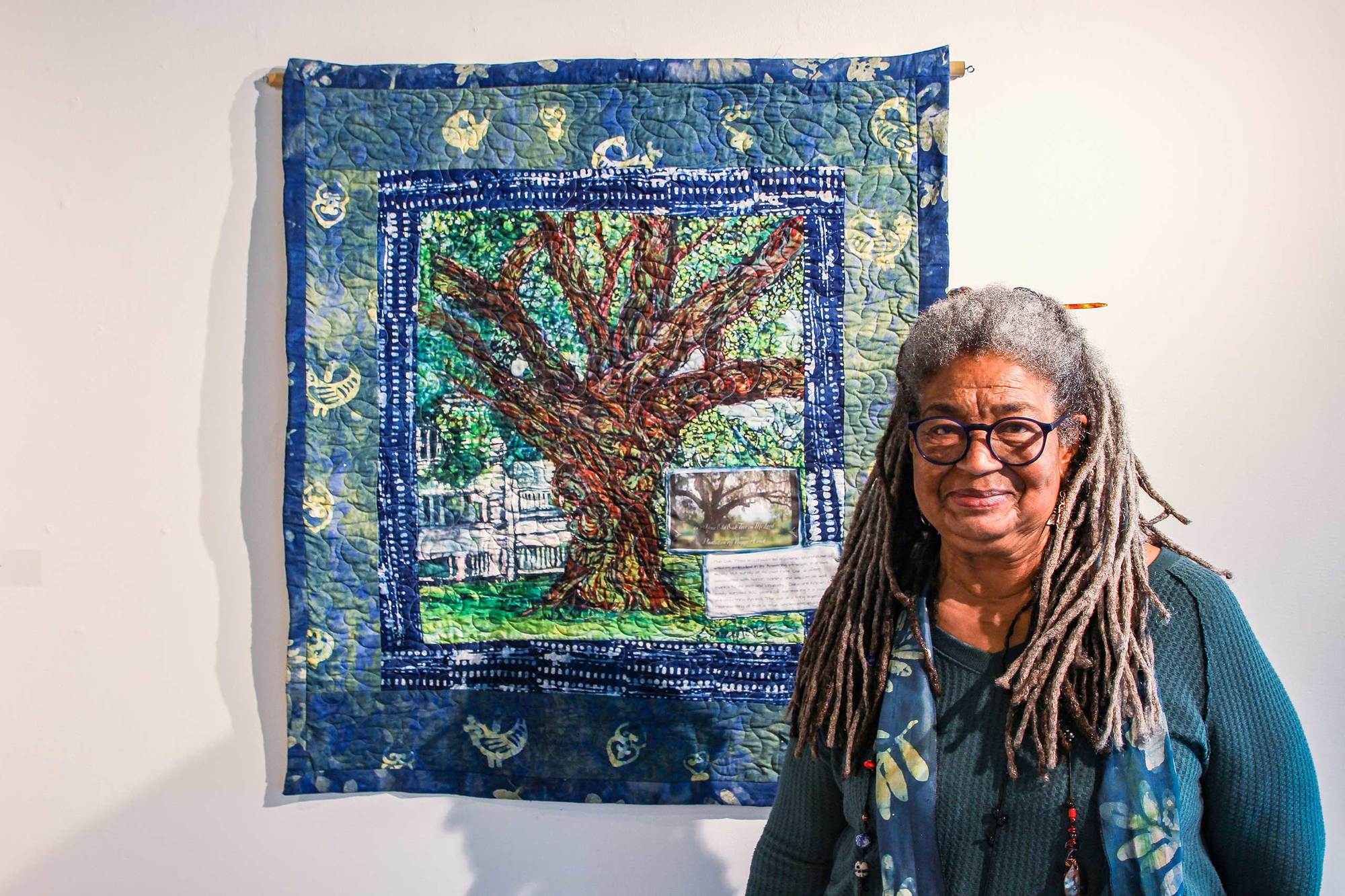
Arianne King Comer is an indigo textile artist based on Wadmalaw Island. She stands in front of her quilt entitled, 600 Year Old Oak Tree on McLeod Plantation, which appeared in the Charleston exhibit Griots of Cotton, Indigo & Clay.
Talia Moore
The Lowcountry’s climate is humid, but mild, and rarely experiences frost. With the right methods, farmers can yield two harvests of indigo in one planting season. So, on St. Helena, King Comer learned to cultivate the plant from the descendants of those people once exploited in the marshlands for their agricultural skill and labor. This is how she found herself approaching a brigade of mosquitos, eager to impart their own lessons. The artist braced herself.
“I thought I was like Johnny Appleseed,” she said, likening her early naïveté to the gusto of the roving 19th century nurseryman. Now, she realized, “Oh. I’ve erred. This [indigo] will die before I get into this.”
Growing agricultural products was not the start nor end point any of these artists had necessarily envisioned.
Indigo is a perennial plant and member of the bean family. With its woody stems, it grows densely like a weed and can reach between three and six feet tall. From October through May, bursts of blush-colored flowers erupt, clustered like jewels amid slender fruit pods that curve upward, bearing miniature black seeds. When the smooth green blades of its branches are gathered and steeped, they provide the dark, rich indigo dye that clings to hands and fingertips immersed in its liquor.
Almost two decades later, King Comer has learned from her mistakes: She now wears tall, sturdy boots when working in the garden, and lots of coconut oil—“mosquitos don’t like it.” She has also since moved her studio to Wadmalaw Island, a lush, green expanse of trees and rushing creeks about 80 miles north of St. Helena. She lives there, too, taking temporary shelter in a camper van, alongside plentiful birds and peckish deer, whom the neighbors gently remind her have long inhabited the six acres where she plans to build a permanent residence and education space. Among the sage live oak trees that ornament the landscape, she plans to grow three species of indigo and sweetgrass seedlings, eager to see what the harvest informs.
The artist-turned-farmer is one of a few Lowcountry textile and fiber artists who are using natural and indigenous materials tied to the history of the Americas and African enslavement, such as indigo, sweetgrass, and cotton, to create and preserve African American material culture through agriculture and artistic expression.
Growing agricultural products was not the start nor end point any of these artists had necessarily envisioned. Yet each felt called to sow and reap from the land the raw materials that inspire their work, as a form of cultural preservation, and in at least one case, because the sustainability of their art form may very well depend on it.
“Everything that I’m doing is coming from the land. I’m growing it, I’m processing it, I’m honoring ancestry,” said King Comer.
—
When I visited in February, pieces of King Comer’s textile dye works were on display at the Charleston exhibit Griots of Cotton, Indigo & Clay, a permanent collection commissioned by Acres of Ancestry/Black Agrarian Fund, a group that promotes African American land-based tenure and traditions throughout the South. Local artist Torreah “Cookie” Washington curated the show, which ran at the City Gallery, a two-story building with floor-to-ceiling glass paneled windows overlooking the Cooper River from the city’s French Quarter.
The river separates Charleston proper from Mt. Pleasant and a handful of so-called settlement communities where African Americans built homes and founded towns after Emancipation. A bridge constructed to join the two almost a century prior has been consequential in both the promotion and decline of the coiled basketry craft practiced in these communities, a tradition that predates American slavery.
More than a dozen Black women artists were featured in the fiber and textile exhibit, employing quilting, appliqué, dye work, and basket-sewing techniques to invoke themes of agrarianism, land stewardship, and cultural preservation. A shrine entitled A Prayer for Flying Africans, and bearing an indigo-dyed, shroud-like cloth marking the names of Black farmers who had joined the decades-long Pigford v. Glickman class-action discrimination lawsuit against the U.S. Department of Agriculture (USDA), and died without receiving fair compensation, honors their legacy.
“We invoked the spirit of our Ancestors, Flying Africans whose will to resist bondage and subjugation, dignified their refusal to be enslaved. Your fight for land, justice, and sovereignty within a system that never wanted you to be free, serves as the North Star for our efforts to materialize your dreams.”
—A Prayer for Flying Africans
“We had to turn to the artists for them to speak in a language that could tap into the hearts and minds of people to really join us in this fight to dismantle anti-Black racism within USDA. That’s the vision of Griots of Cotton, Indigo & Clay,” said Tracy Lloyd-McCurty, executive director of the Black Belt Justice Center, a sister organization to Acres of Ancestry, focused on land justice and legal advocacy. “If we steward the land, do we also not have a responsibility to be stewards of Black agrarian material culture?” she asked.
The exhibit will run from April through early October at the I.P. Stanback Museum and Planetarium at South Carolina State, a historically Black land grant university in Orangeburg, a little over an hour northwest of Charleston. There, the museum’s executive director, Frank Martin, presides over an impressive collection of cultural artifacts: the original photographic panels from the controversial 1969 Metropolitan Museum of Art exhibit “Harlem on My Mind;” Cecil Williams’s visual documentation of the Civil Rights Movement; a collection of Andy Warhol polaroids, among African sculptures and African American art.
King Comer previously showcased at the Stanback, which is how she and Martin came to think about applying for grants to experiment with indigo. Martin had a vision for a project that could involve multiple colleges, students and professors of various disciplines, community stakeholders, and perhaps most importantly, local government. As part of a proposal to study the feasibility of indigo as a Lowcountry cash crop for small-scale producers, Martin approached farmers and artists, asking if they would consider growing a portion of the crop in different varieties and environments, under varying conditions—sand, loam, clay.
It may seem like a stretch for an art museum director to seek an agricultural grant, but Martin was quick to note that I.P. Stanback is also a planetarium, grounded in scientific exploration, and its founding director Leo Twiggs is a Lowcountry artist who paints with indigo dye on cotton—a political statement about the region’s history and heritage, Martin said. He has his own agricultural background as well, describing himself as a “farm kid” who grew up working on cotton and tobacco fields.
“The idea is to help our students in South Carolina and the South look at these traditions that were brought into this hemisphere by their African forbearers, and to be more aware of the importance of those individuals in the early economic development of this state. This was, at one time, the wealthiest state in the 13 colonies largely because of African craftspeople who grew rice and indigo, and later, cotton,” Martin said. He’s hoping to submit a USDA grant proposal by late fall or early winter.
“Everything that I’m doing is coming from the land. I’m growing it, I’m processing it, I’m honoring ancestry.”
Like so many details related to the history of the Lowcountry, the value of rice is integral to this story. When British colonists arrived in South Carolina in 1670, they experimented with a variety of crops such as cotton, olives, and tobacco to determine which could yield the most money and deliver the best return on capital investments. By 1690, rice had emerged as the state’s most profitable crop, and one without competition throughout the other British colonies. By 1720, it was the state’s primary export. But as tensions increased between England and Spain over the following two decades, eventually exploding into a war that made shipping rice across the Atlantic to England extremely dangerous and expensive, planters and provincial authorities became eager to diversify their market.
“The history of indigo in South Carolina is intimately connected to the cultivation of rice,” said Nic Butler, historian at the Charleston Public Library. “The reason indigo became a commercial crop is because of the collapse of rice prices in the late 1730s and early 1740s. Around this time, people in South Carolina are scrambling to come up with another crop they can ship out to the other colonies, if not across the Atlantic.”
“If we steward the land, do we also not have a responsibility to be stewards of Black agrarian material culture?”
“On the Sea Islands you’ve got a bit of a microclimate that’s different from the mainland areas—coastal or inland areas. One of the many reasons that people decided to settle on indigo as a secondary crop in the 1740s was because it will grow on a variety of soils that are not really great soils—and specifically—it’s a different kind of soil than rice. Rice is a swampy process, but indigo has to be on high land,” said Butler.
Harvesting the crop and transforming it into dye is also extremely labor-intensive. In South Carolina’s plantation economy, every six or seven acres of indigo planted required a system of vats used to steep the leaves and extract and process the dye into dried powder cakes that could be shipped long distances. Despite the free human labor planters exploited, those infrastructure costs subtracted from profits. Butler cites a 1755 essay from Gentleman’s Magazine of London that describes the process of cultivating 50 acres of indigo as requiring 15 “hands,” enslaved men and women, to maintain the crop, and at least 25 “very able hands” to process the dye.
“A lot of people have this kind of, what I call a Gone With the Wind idea of what a plantation is—just crazy,” Butler said. “A plantation is a labor camp.… Rice and indigo are very labor-intensive. The only way to make that labor-intensive process profitable was to employ unfree labor. Without slavery, they would never have considered doing this.”
There are, however, limits to innovation. Most urgent: extinction.
This is a challenge that modern-day growers must contend with. Often, amateurs plant small plots in order to reap a manageable harvest. Charleston-based David Harper, treasurer of the International Center for Indigo Culture, a nonprofit, is married to an indigo artist and has, since 2015, grown a tropical South American variety of the plant—the same variety cultivated by enslaved Africans in South Carolina for its long-lasting pigment—to use in his wife’s dye work and workshops. He is also one of the candidates that Martin at SC State, has enlisted to join his proposed trial to study the crop’s feasibility. Independently, Harper has also secured funding, through a USDA value-added producer grant, to work with small farmers who share an interest in reviving its use. He and his wife currently have between 600 and 700 plants divided between two quarter-acre plots.
“Every year for the last seven years we’ve left crop in the field because we just couldn’t process it,” he said. That’s one reason why you don’t see indigo dye houses popping up all over the place. Inevitably, you’re doing this really laborious process with almost the same techniques that were used by enslaved people on plantations in the 1700s. Even with better equipment it’s still a bottleneck, it’s still inefficient. That’s one reason we’re going for grants to try to streamline that process so that small farms could benefit from a more efficient production system.”
—
Like Lowcountry indigo cultivation, the sewn sweetgrass baskets featured in Griots of Cotton, Indigo & Clay by artist Georgette Sanders are borne out of African knowledge and American enslavement. The baskets, contemporarily sewn from native sweetgrass—so ubiquitous with South Carolina history that the state named them the official Lowcountry handicraft in 2006—evolved from the 17th and 18th century plantation baskets made from hardy bulrush bonded with white oak splints or soft palmetto, and fashioned into fanner baskets, used by enslaved Africans to winnow rice.
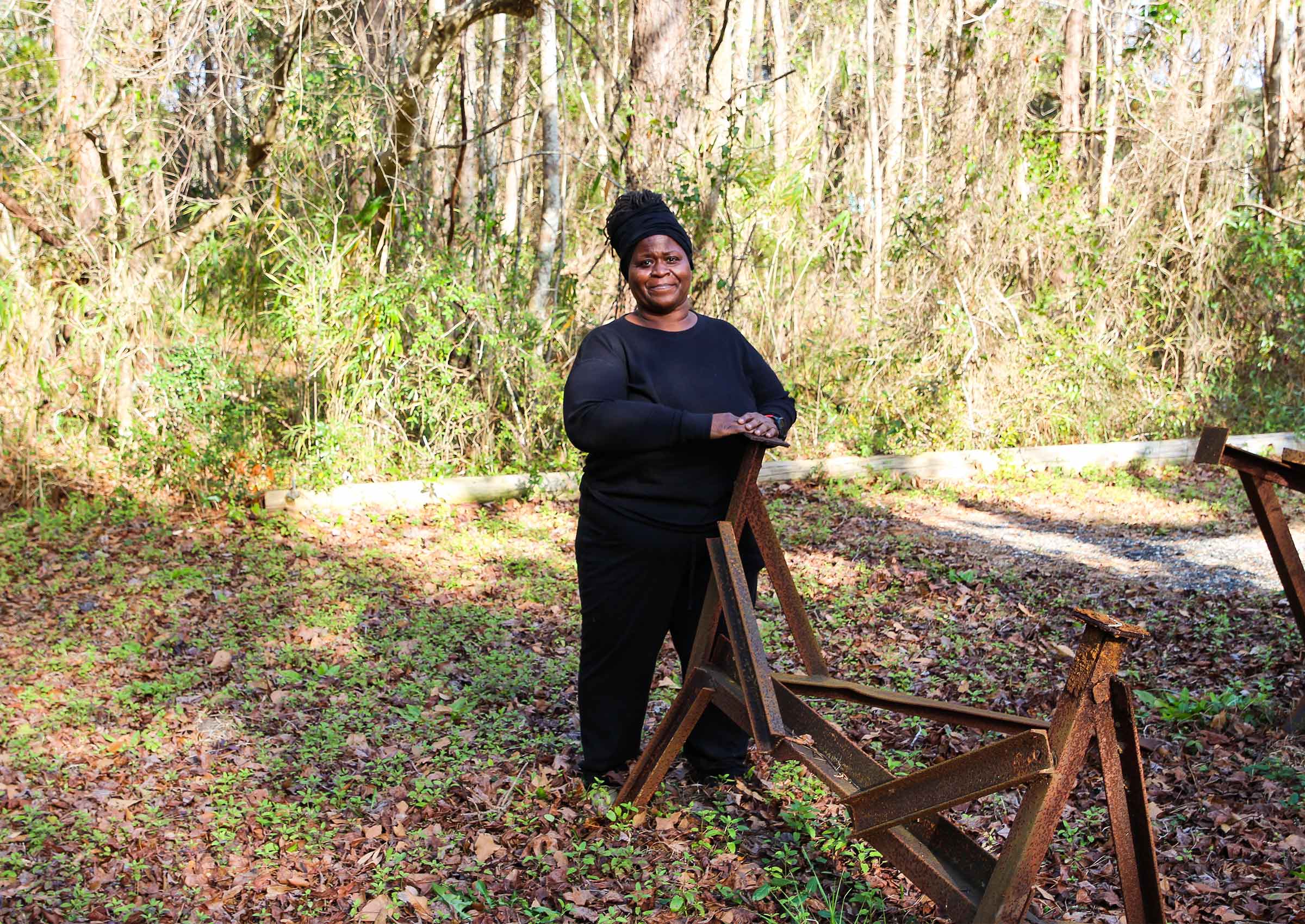
Georgette Sanders is a visual artist who combines basketry, pottery, and beadwork in her pieces. Sanders embraces the Gullah-Geechee traditions of the native crop while incorporating new methods into her art form. She was taught how to sew sweetgrass by her aunt nearly four decades before and continues to keep the traditions alive by teaching her granddaughters.
Talia Moore
Sanders learned to sew them about four decades ago from an aunt. Like so many artists, she said she receives visions of inspiration in her dreams, and recounted awaking abruptly one night about 17 years ago, washed in images of clay. Then newly married, her unsuspecting husband quickly realized his ignorance.
“He said, ‘You don’t sleep much, huh?’” Sanders tilted her head, appearing briefly apologetic through a burst of laughter. Since then, she’s incorporated smooth, kiln-fired clay into her handsewn basketry. The materials Sanders employs, clay and beadwork, are not tradition but invention. It’s an aspect of the craft that she treasures: the evolution of an object once made for function now interpreted as artwork.
“Each generation shifts. It’s no longer a bread dish, or a set of coasters,” she said. “Your older customers are asking for things that may be products gone by, and they need to preserve them because it may never get back to someone making pot rests. Grandmother may have done that, and mom may have made purses or hats. Now, you’re thinking of big, broad, massive pieces, being in museums. You’ve got the art coming out. Each phase was beautiful for that generation. I’ve started to teach my granddaughters, and I can’t wait to see what they do. If you bought a basket 30 years ago, you really need to be investing in one now just to see how it has evolved.”
There are, however, limits to innovation. Most urgent: extinction.
“There are very few teenagers that are going to sit around with their moms and grandmas selling baskets like in the old days. So it’s becoming even harder to pass the tradition on to the next generation.”
Basketry has long been a means of economic self-sufficiency throughout the Lowcountry’s African American communities. There exists a well-established history of enslaved people using this skill to barter goods and earn income to purchase or maintain their freedom, as well as to escape. A year before the Civil War ended, an enslaved man named Jack Frowers made headlines when he wove grasses and rushes to construct “a basketry boat,” using cotton to caulk it and tree gum to waterproof it; then sailed his way to freedom, escaping to the Union-occupied side of South Carolina’s Port Royal Sound.
“Nothing produced in the Lowcountry has had the power to evoke South Carolina’s African inheritance over such a long period of time as has the coiled basket,” historian Dale Rosengarten writes in the book Grass Roots: African Origins of an American Art.
Yet today, despite the rise and proliferation of e-commerce and digital shopping platforms, it’s gotten much harder for many sewers to make a living selling sweetgrass baskets. To understand why, a drive up Highway 17 North from Charleston to Mt. Pleasant, over the Cooper River Bridge was instructive.
With paving of Highway 17 and completion of the Cooper River Bridge in 1929, basket sewers from settlement communities had a means to reach customers directly. They began to display their baskets on chairs and crude highway-side stands, advertising to drivers. By 1949, 31 stands were identified along a two-mile stretch of the highway.
In the aftermath and clean up of debris from Hurricane Hugo, which hit South Carolina in 1989, residential and commercial development in the area exploded. Between 2009 and 2013, a five-mile stretch of the highway was widened further, from four to six lanes. Ironically, the road now dubbed “The Sweetgrass Basket Makers Highway” doesn’t support much basket-selling. The majority of stands were moved and replaced, and it can be dangerous for drivers to attempt to pull off on the side of the road. Sweetgrass habitats continue to be cleared to make way for gated condos and housing developments, while the borders of land once considered part of African American settlement communities continue to shrink.
When, in the 1980s, Rosengarten joined a project to interview basket makers about their craft, she asked sewers what they felt was the most serious threat to the tradition.
“Everyone, every single one said, ‘The difficulty of finding sweetgrass, that’s the most pressing problem we have,’” she said. “That started in the 1970s already.”
Sewers came up with a workaround. They began reintroducing bulrush, which was abundant and used historically to create plantation work baskets. Researchers, most notably Bob Dufault, a former Clemson horticulturist, undertook massive decades-long efforts to study and repopulate the indigenous, perennial grass. Those efforts yielded mixed results; as Rosengarten noted, there is an abundance of the grass in Mt. Pleasant and along highway dividers and coastal areas today, but much of it is decorative and too brittle to sew with.
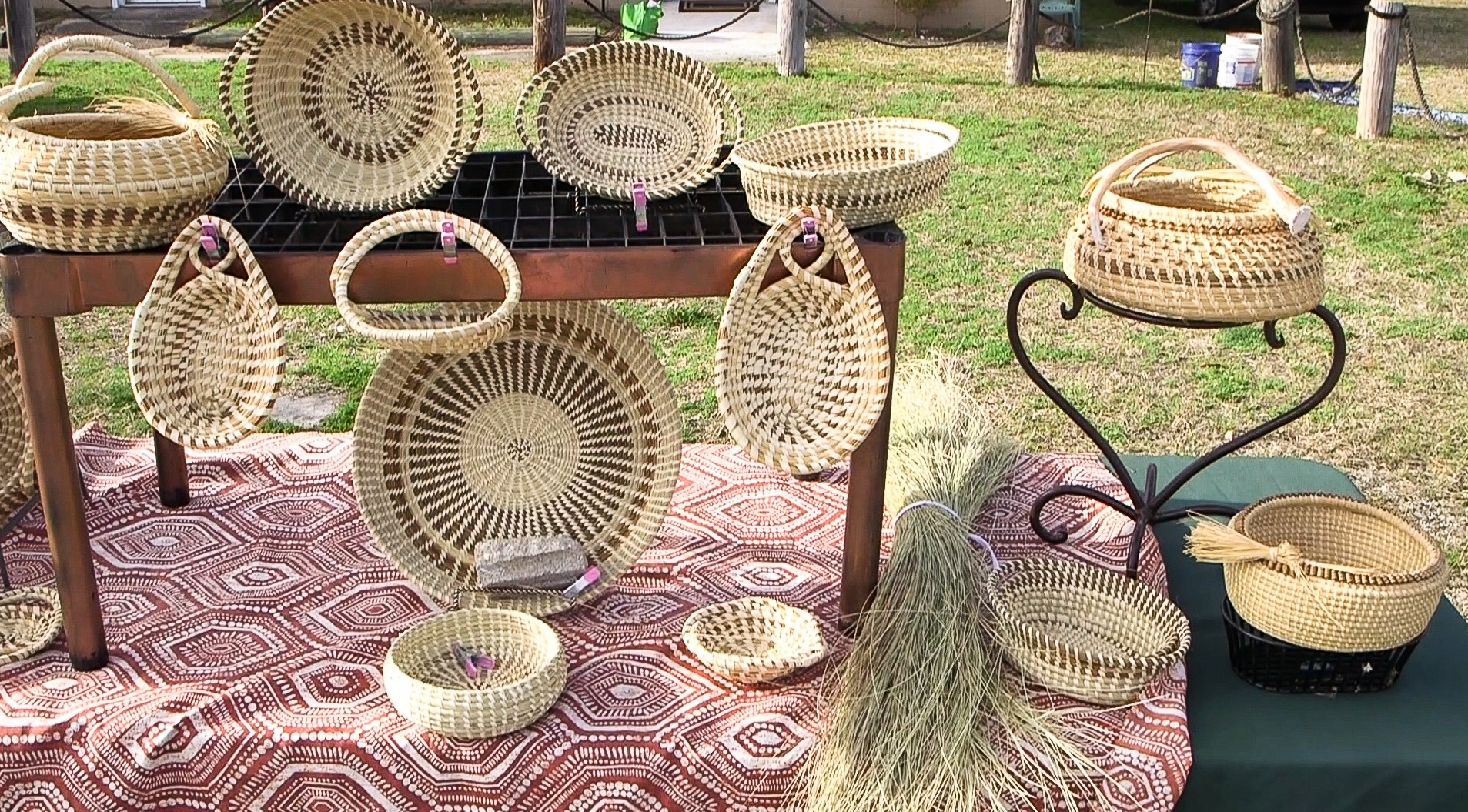
Basketry has long been a means of economic self-sufficiency throughout the Lowcountry’s African American communities. Sanders’ display of sweetgrass baskets outside of her studio in McClellanville, South Carolina.
Talia Moore
While this is still a problem, she now believes that development poses the greatest threat.
“It’s a full-on assault,” said Rosengarten. “This rampant development is really threatening the communities themselves where these sweetgrass basket makers live. At the same time, the young people in those families have lots of competing activities and interests. There are very few teenagers that are going to sit around with their moms and grandmas selling baskets like in the old days. So it’s becoming even harder to pass the tradition on to the next generation.”
In the decades preceding the further widening of Highway 17, Mt. Pleasant’s population more than doubled, yet virtually all of its new residents were white, said Rosengarten. In 1990, Black people accounted for about 16 percent of the population. By 2000 they numbered less than half of that. As of 2020, Black people represented only 4 percent of the town’s residents.
Kennedy Bennett was born and raised in Mt. Pleasant, where she grew up among a community of sewers: her mother and grandmother, church members, neighbors. It’s a skill the Yale student has not yet mastered, but not for lack of trying. Though much of the development that took place in the area came long before she was born, she’s old enough to recognize the changes that have materialized since she was in secondary school.
“Land that used to be publicly available where sweetgrass grows, basket makers can no longer access because it’s now private property and there are trespass notices, or there’s a house there.”
“The community I grew up in was mostly Black. The houses that were there had been there for a really long time. Even if I didn’t know the elders personally, they knew who I was because they knew my mom and my grandparents. Now, driving around some of the settlement communities, you can tell they’re being gentrified. Dynamics have changed. There are huge apartment buildings and parking garages that obstruct the views,” Bennett said.
“Land that used to be publicly available where sweetgrass grows, basket makers can no longer access because it’s now private property and there are trespass notices, or there’s a house there.”
Dufault, the former Clemson researcher who devoted years in efforts to repopulate sweetgrass, has encouraged home and landowners to grow it wherever they can. Sanders, the sweetgrass and clay artist, is trying her hand at it. She will plant grasses behind her studio, not far from the towering oak tree where she takes shade with her grandchildren, dictating Gullah language lessons in McClellanville, further north of Mt. Pleasant; an area where the weavers who have not abandoned their stands have migrated toward in an attempt to beat the traffic. She will also cultivate sweetgrass on a patch of her husband’s family land.
—
Small, experimental, yet historically rooted farming like this, is how many artists are attempting to explore and preserve African American heritage.
Textile artist LaChaun Moore is a Maryland native and Parsons School of Design graduate who moved from Harlem to the small, unincorporated community of Pineland, a little over 80 miles west of Charleston, to begin farming indigo and naturally colored cotton in 2018. She explores the connections between the natural dyes and fiber making methods she learned about in the classroom, and how they relate to Indigenous and African American cultures in the South.
At Parsons, Moore studied integrated design. She described it as a program where students could build the focus they wanted their work to have.
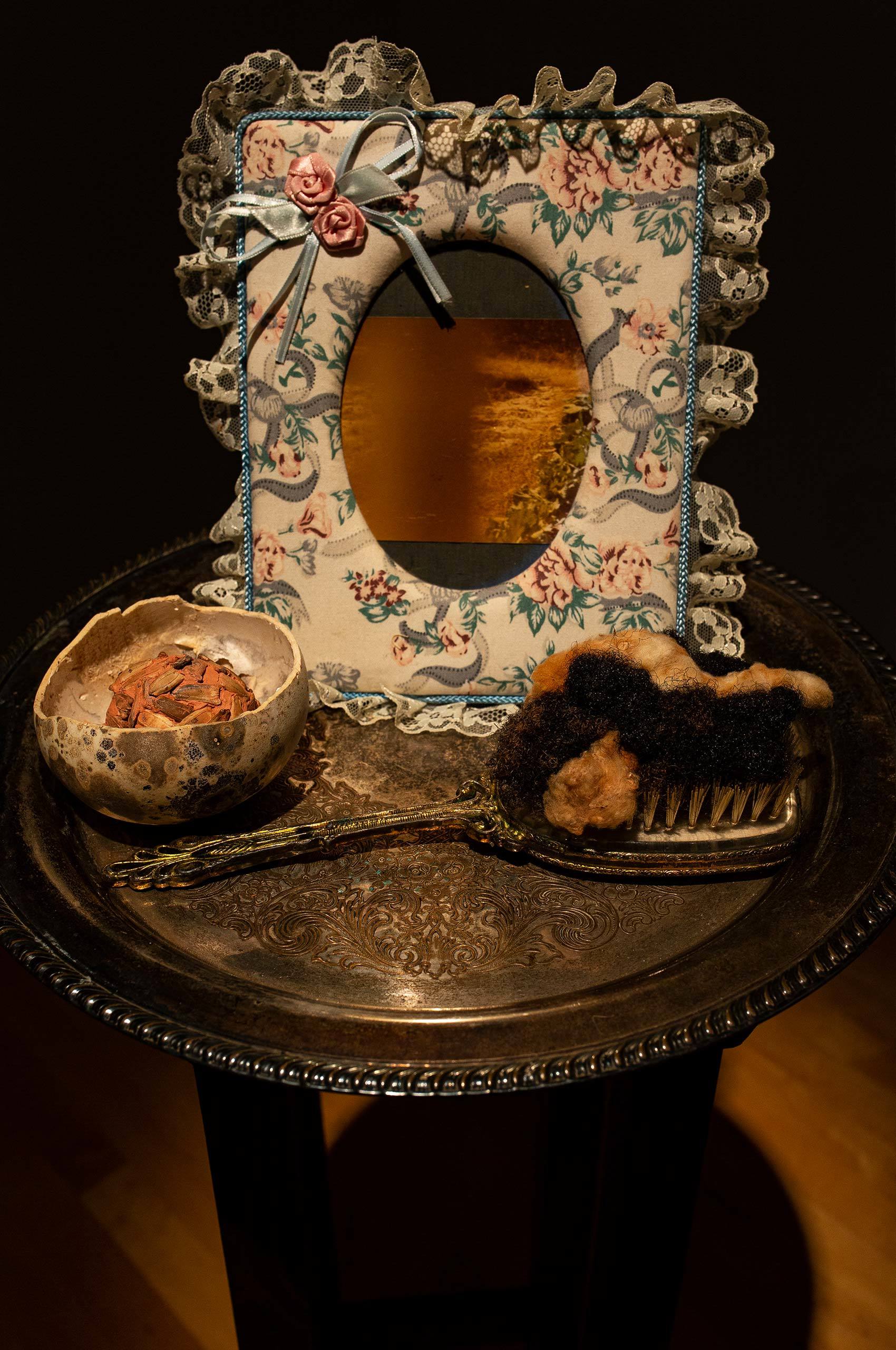
A piece from the “LaChaun Moore: 17845” exhibit at The Hilliard Museum in Lafayette, Louisiana.
The Hilliard Museum
“Most of us were textile artists who aren’t necessarily interested in runway shows, maybe not super interested in celebrity culture, but love garment making and the history of fashion,” she said. “Or come from a culture that has really strong textiles and want to find a way to bring what they know about textiles into a commercial garment making industry. I’ve always been interested in clothing and history, specifically uniforms. I make garments, but I also make installations.”
In Pineland, Moore began her experimentation by dividing the indigo and naturally colored cotton in shades of green and brown over about a quarter-acre for each.
“I planted the indigo at least three times, and it wasn’t until the third that I actually got the seeds to germinate,” she said. Moore had grown produce in community gardens in New York City where she was used to working with dirt. “South Carolina has sandy, loamy soil, which is completely different. It has very little nutrients, but it’s the perfect soil for the crop. I just had to learn how to plant it.”
She learned that she had to plant the seeds shallow, rather than dig a deep hole and cover it. “You don’t want to smother the seeds,” Moore said. To make sure they opened up, she soaked them in a bowl of hot water the evening before planting. This makes them “sweat and swell,” opening up the case of the seed and increasing the chance it will grow into a plant. Once you see established leaves, she said, they can virtually fend for themselves, though they do require consistent watering and nutrients.
That was before the pandemic, when Moore returned to her childhood home, longing for family. In March, she returned to South Carolina, this time to Johns Island, less than 30 minutes west of Charleston, where she aims to increase her planting to an acre of indigo and half an acre of naturally colored cotton, in addition to growing some medicinal herbs, along with birdhouse and luffa gourds.
In a way, the artists’ foray into agriculture represents a new iteration in their artistic development. Art is, at its core, experimentation. A process that facilitates discovery, and ultimately leads to new forms of expression. In that way, the two seemingly disparate spheres intersect. As farmers and advocates work to stop the acceleration of Black land loss and material culture, these artists have become part of that fight, holding fast to the values and traditions borne from Black agrarianism.
Additional reporting contributed by Talia Moore and Tricia Vuong.
